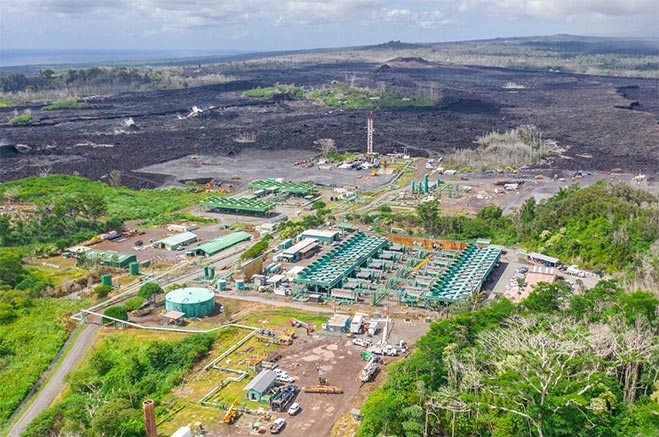Hawaiian Electric, Puna Geothermal Venture reach new agreement to reduce cost, expand output
Customers to save close to $13 per month by 2023
Release Date: 1/3/2020

HILO, Jan. 3, 2020 – Hawaiian Electric and Puna Geothermal Venture (PGV) have reached agreement on an amended contract that will significantly lower electric bills on Hawaii Island, reduce greenhouse gas emissions and expand the island's renewable portfolio standard to nearly 70 percent.
The amended power purchase agreement was filed with the Public Utilities Commission (PUC) on Dec. 31, 2019 for its review and approval.
An added benefit of the new contract is the upgrade of the 38-megawatt geothermal facility to produce an additional 8 megawatts of firm, lower-cost renewable energy, further reducing bills and the use of fossil fuels to generate electricity.
Once the upgrade is completed, typical residential bills are expected to drop about $7.50 a month starting in 2022 and close to $13 a month in 2023, based on current prices.
An important element of the amended contract is that the rate paid by the utility to PGV will be fixed and no longer be linked to the price of oil. By eliminating the volatility of oil prices from the rate paid to PGV, the new fixed-price contract will ensure that bills are more stable. This new pricing arrangement follows guidance provided by the PUC.
"We thank our regulators for the opportunity to revisit the agreement and find solutions that will reduce customer bills," said Sharon Suzuki, president of Hawaiian Electric's Maui County and Hawaii Island utilities. "The pricing of renewables has dropped significantly in recent years. The owners of PGV recognize that and we appreciate their willingness to sit down and work with us on an amended contract that benefits customers and accelerates our transition to 100 percent renewable energy."
The PGV facility in Puna, which began operations in 1992, has been shut down since the eruption of the Kilauea Volcano in May 2018. Currently, power production from oil-fired generators has been expanded to make up for the loss of the PGV facility.
In June 2019, Hawaiian Electric's subsidiary, Hawaii Electric Light, filed an application with the PUC to rebuild two transmission lines that would reconnect PGV to the grid. In August 2019, the commission suspended the proceeding and gave PGV and the utility until Dec. 31 to provide information regarding an amended agreement.
Assuming the transmission line construction is approved and other repairs are completed on schedule, PGV expects to resume operations in 2020. The loss of PGV has increased electric bills by about $2 a month.
"We have enjoyed a long and successful relationship with Hawaiian Electric and Hawaii Electric Light and are grateful for its support of geothermal power," said Isaac Angel, chief executive of Ormat Technologies, Inc., the owner of PGV. "We are proud to partner with Hawaiian Electric and enable Hawaii's commitment to clean energy and reducing greenhouse gas emissions. As Hawaii continues to pursue the goal of achieving 100 percent of its electricity generation from renewable sources, PGV is an increasingly critical source of renewable energy and capacity, unaffected by volatile fossil fuel pricing, in this region."
All of the repairs, including rebuilding the transmission lines and the switching station that ties PGV into the grid, are being done at no cost to utility customers.
The existing contract between Hawaiian Electric and PGV expires in 2027 and remains in place until it is succeeded by the amended contract when the upgrade is completed in 2022. The proposed amended contract would expire in 2052.
Until the eruption, Hawaii Island led the state in renewable energy production. If the amended contract is approved, once the additional 8 megawatts of firm power come online Hawaii Island's renewable energy total will be close to 70 percent.
The plant's additional production will also displace about 160 million gallons of oil over the life of the contract, significantly reducing greenhouse gas emissions.


